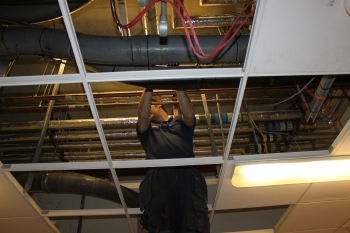Carbon steel as the greener piping solution

When specifying any product, cost and, increasingly, sustainability are key issues. Simon Spridgeon of Geberit, looks at the benefits of carbon steel as greener alternative to mild steel that can also significantly reduce overheads when used as part of a press-connection system.
Traditionally, mild-steel screwed pipework has been the fail-safe for applications like closed-circuit heating, chilled water and wet sprinkler systems, solar heating and compressed air. A better solution, and one that is increasingly being adopted, is carbon steel with press-fitted connections – now widely used thanks to its corrosion resistance in closed heating and chilled-water systems. Boasting enhanced eco credentials plus money-saving benefits, as long as it is installed correctly, carbon steel makes for a convincing alternative.
Carbon steel is up to 50% lighter than traditional mild-steel pipe. This means that not only is installation easier but also as carbon steel uses fewer materials it produces less CO2 during manufacture. Furthermore, there is less environmental impact in terms of transportation.
The overall cost of a job can be reduced considerably by choosing a pressing system, which dramatically cuts down installation time without compromising on safety. For example, Geberit’s Mapress system, which is available in carbon steel, reduces costs by over 35 per cent, according to a BSRIA report, when compared to traditional welded pipe.
One of the key benefits of carbon steel is its anti-corrosive nature in closed-circuit systems. However, correct storage, handling, installation and commissioning is key, as problems can occur when manufacturers’ guidance is not followed.
Keep it clean: Prior to fitting, the piping must be protected from dirt, damage and, ideally, transported in its original packaging. Carbon-steel products should not be stored alongside stainless-steel items to avoid contact corrosion.
Keep it dry: Pipes should be protected against moisture and the influence of weather, with the temperature not dropping below the dew point. For chilled-water applications, a vapour barrier must always be maintained in areas where condensation is likely to occur.
Carbon-steel pipe is available coated in plastic, meaning extra protection is not required, apart from on any uncovered fittings and pipe ends.
Keep it oxygen free: Crucially, the probability of corrosion is increased if oxygen is present in the circuit; concentrations in excess of 0.1 g/m3 indicate a greater probability of corrosion. This could occur through compression glands, screw connections or automatic air-vent valves if there is negative pressure in the heating system. There is no risk of corrosive damage from oxygen that enters when filling and supplementing with water since the amount of oxygen is very low.

Correct commissioning: Installers should not be tempted to test sections of pipe with water as they go along, draining them down in between. Residual oxygen and water in the pipework can begin the corrosion process, which once it is started it is almost impossible to stop.
Further measures to delay corrosion in carbon steel pipework include adding an oxygen-binding substance to the circulating water, setting the pH value at 8.5 to 9.5 and only using water additives tested and approved by the manufacturer.
Any potential pitfalls of installing carbon steel are simple to avoid, and it is well worth the small amount of extra effort required when you consider the long-term gain of a more ecologically sound construction.
The Mater Hospital An example of good-practice carbon steel is the Mater Hospital in Ireland, where Geberit Mapress carbon-steel pipework was installed some 12 years ago. A recent revisit to the hospital revealed corrosion-free pipework as effective as the day it was commissioned. This example proves that with just a few simple precautions carbon steel could well spell a whole new way of thinking for installers looking for a greener, more cost effective alternative to steel and copper pipework. In fact, Geberit Mapress carbon steel has a service life in excess of 25 years.
By adhering to manufacturer’s guidelines, carbon steel presents a long lasting, eco-friendly and, in the case of pressed pipe, lower-cost alternative to its traditional counterparts —one that is well-worth considering for a wide variety of applications.
Simon Spridgeon is product and technical manager for Geberit.








